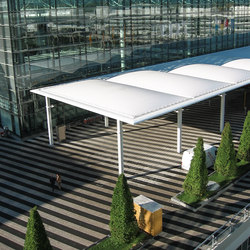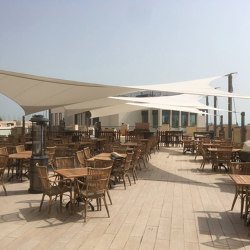Canopies
Pergolas from Koch Membranen
Product description
The particularity of pneumatically pre-tensioned constructions is that they consist of a layer that is subjected to tensile stress, which encloses a volume of air, in a manner similar to air bubbles or balloons. With such a structure, two-ply or multi-ply cushions are filled with air via a blower and are kept under pre-tension through the excess pressure that occurs. The pre-tension forces that occur and the work loads, such as wind or snow must be absorbed through the adjacent subconstruction. Pneumatic constructions are particularly well-suited as closed building shells if rigorous requirements are imposed on the thermal balance of the structure, or for transparent construction where primarily ETFE films are used.
Concept
There are few areas where attractive design and efficient construction are as closely intertwined as in textile / membrane construction. Whether used for buildings that pose a challenge from an engineering standpoint or for flexible, temporary structures – lightweight constructions allow for an unlimited range of shapes and impressive structures boasting enormous span widths. The primary purpose of textile constructions is and always has been to provide the best possible protection against the weather. The best products in this category provide this protection in the most economical and ecological way - at minimum use of material and maximised reduction of weight.
Possible applications
No matter if they are used for rigid or for single or multi-layer textile structures in building shells, membrane materials set themselves apart by their unique design and technical characteristics. Prime examples of the material's versatility are mobile, collapsible membranes used to span stadiums or atriums or membranes used in classic tent or pavilion structures. As they can be shaped into any type of construction including sails, arched roofs, tents, umbrellas or pneumatic structures, membranes allow for a whole plethora of possible textile structures and designs.
Selection of materials
The created architecture owes its distinctive look and feel to the selected materials and their surfaces – whether the material is wide-arching fabric or pneumatic foil cushions. The material is always selected to fit each specific application perfectly. The decision on the appropriate material hinges on the design principles, the ambient and environmental conditions and such factors as light permeability, durability or cost. Other aspects influencing the decision include the handling, workmanship or force-stretch behaviour of the material. Finding and tailoring the material that is best for each specific construction project calls for a detailed and profound knowledge of the different materials. In contrast to glass construction, textile architecture has come to the fore for many planners thanks to its impressive environmental footprint and outstanding economy.
Materials suited for textile architecture
PVC-coated polyester fabric
PTFE fabric
PTFE-coated glass fabric
Silicone-coated glass fabric
ETFE foil
Custom-engineered special fabrics
Possible applications
No matter if they are used for rigid or for single or multi-layer textile structures in building shells, membrane materials set themselves apart by their unique design and technical characteristics. Prime examples of the material's versatility are mobile, collapsible membranes used to span stadiums or atriums or membranes used in classic tent or pavilion structures. As they can be shaped into any type of construction including sails, arched roofs, tents, umbrellas or pneumatic structures, membranes allow for a whole plethora of possible textile structures and designs.
Selection of materials
The created architecture owes its distinctive look and feel to the selected materials and their surfaces – whether the material is wide-arching fabric or pneumatic foil cushions. The material is always selected to fit each specific application perfectly. The decision on the appropriate material hinges on the design principles, the ambient and environmental conditions and such factors as light permeability, durability or cost. Other aspects influencing the decision include the handling, workmanship or force-stretch behaviour of the material. Finding and tailoring the material that is best for each specific construction project calls for a detailed and profound knowledge of the different materials. In contrast to glass construction, textile architecture has come to the fore for many planners thanks to its impressive environmental footprint and outstanding economy.
Materials suited for textile architecture
PVC-coated polyester fabric
PTFE fabric
PTFE-coated glass fabric
Silicone-coated glass fabric
ETFE foil
Custom-engineered special fabrics
More about this product
Categorised in Small structures - Textile architecture - Roof - Pergolas - Textile buildings - Membrane roofing - Urban space.
Part of the collection
Our Solutions For Outside.
Manufacturer
Koch Membranen
Family
Canopies
Architonic ID
1435851
More products from Canopies family
Related Projects
Contact information
Address
Nordstrasse 1, 83253 Rimsting/Chiemsee Germany
Get more information
Sign in to your Architonic account to have your contact details filled out automatically for each request.

More from
Koch MembranenContact information
Address
Nordstrasse 1, 83253 Rimsting/Chiemsee Germany


